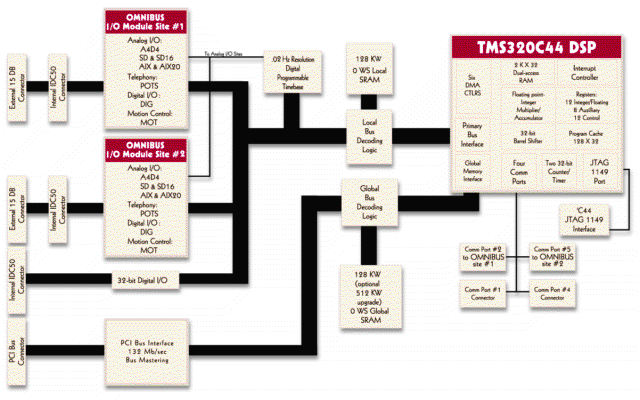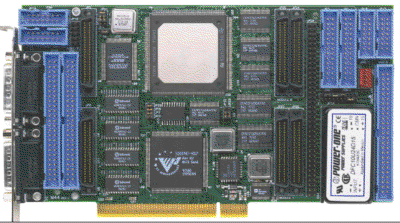M44 Flexible DSP/Data Acquisition Platform
Overview
The M44 board provides a flexible platform for a wide variety of DSP-based data acquisition applications. It represents an evolution of DSP-based "smart" data acquisition boards:
- powerful but inexpensive 32-bit floating-point DSP
- PCI bus controller for high-rate transfer/streaming of data to host RAM (up to 40 Mbyte per sec, depending on host system)
- small form factor
- flexible and expandable acquisition of real-world signals
The PCI controller obviates the need for dual-port RAM or other complicated host interface circuitry, allowing more onboard area dedicated to number-crunching and data
acquisition capability than with previous generations of boards, yet still consuming no more than half-size PCI board space.
The M44 baseboard is available in two (2) form factors:
- half-size PCI (standard PC)
- 6U cPCI (Compact PCI)
Both M44 board types include a 40 or 60 MHz TMS320C44 32-bit floating-point DSP controller, two banks of SRAM (local and global) which can each be 128k or 512k x 32
(total of 1M x 32 SRAM expansion), and 32-bit digital I/O. In addition the baseboard is low-cost; for example a 40 MHz board with 128k x 32 local SRAM is less than USD 1000,
making it attractive for applications requiring DSP acceleration and high-rate PCI bus-mastering data transfers.
M44 Analog and Digital I/O Modules
The M44 input/output philosophy is entirely modular, providing two (2) daughterboard sites for a wide array of "OMNIBUS" modules, including:
- A4D4 4-channel 16-bit 200 kHz SAR analog I/O with 6-pole anti-alias filters and 2-pole reconstruction filters, and software programmable gain; multiplex option available
- SD4 4-channel 24-bit 96 kHz sigma-delta analog I/O; 104 dB SNR typical
- SD16 16-channel 16-bit sigma-delta analog I/O, 82 dB SNR typical (no longer supported for M44; please see information about M67 board )
- S16-HS High-Precision 16-channel 16-bit dc to 195 kHz sigma-delta input; high level of dc accuracy (no longer supported for M44; please see information about M67 board )
- A16D16 16-channel 16-bit 100 kHz SAR analog I/O with 2-pole antialias filters and 1-pole reconstruction filters (no longer supported for M44; please see information about M67 board )
- AIX 4-channel 16-bit 2.5 MHz SAR input, with anti-alias filters
- AIX20 4-channel 12-bit 20 MHz SAR input
- DAC40 4-ch 14-bit 40 MHz SAR output
- A16D2 16-ch 16-bit 2 MHz multiplexed input, 2-ch 16-bit simultaneous output (no longer supported for M44; please see information about the M67 DSP/data acquisition board
- Analog I/O Breakout Panel
Note that because the M44 contains two (2) module sites, modules can be doubled to provide 2x channel capability (the numbers in parentheses above), and modules can also be
mixed, to provide flexible data acquisition combinations.
M44 Telecom Modules
The M44 input/output philosophy is entirely modular, providing two (2) daughterboard sites for standard "OMNIBUS" telecom modules, including:
- TELCOM24 24-DSP telecom module with sigma-delta analog I/O option
M44 Specifications and Data Sheets
M44 Block Diagram
Below is a block diagram depiction of the M44 and its architecture and components, including OMNIBUS module sites. Note that in any cases where the block diagram and
specifications above disagree, the specifications above are correct:

M44 Software Support
The M44 board is supported by Signalogic off-the-shelf DSP software products designed for DSP-based data acquisition and C4x DSP code development. The software items listed below use VxD device drivers developed
by Signalogic, and provide support for the M44 under Win9x, and Windows ME. Kernel-mode device drivers for Windows XP are currently under development.
Hypersignal®-Macro/a> and Hypersignal-Acoustic
software series, which offer a number of simulation and real-time instrument functions. Simulation functions include DSP and math functions, time domain display (including
waterfall, contour, magnitude, unwrapped phase), difference equation, digital FIR and IIR filter design, sampling rate conversion, frequency zoom, wavelet transform, minimum phase
calculation, and many more. Instrument functions include spectrum analyzer, digital oscilloscope, stimulus & response measurement, continuous signal generation, real-time
"snap-in" filtering, continuous disk record and generate, and more.
DirectCore® is a Windows library which provides low-level and high-level calls for user-defined C/C++,
Visual Basic,
MATLAB®, or
LabVIEW® programs. DirectCore includes low-level M44 board control functions such as reset/run/hold, register access,
block memory transfer, DSP executable file download, etc. High-level functions include waveform file acquire/generate, continuous signal generation, and execution of any
arbitrary Hypersignal DSP or math function. DirectDSP includes strip-chart recorder, digital oscilloscope and digital tape recorder demo program and source code examples.
The TMS320C4x
Source Code Interface contains numerous C4x algorithms and functions in source and binary form, such as optimized FFTs, filters,
matrix, transcendental, trig, signal manipulation function, M44 board initialization and analog I/O examples, etc. These functions form the basis of higher-level software
functions and instruments; modification can be used to customize Hypersignal or DirectCore operation. User-defined C routine hooks are provided for real-time algorithm development.
The C4x Source Code Interface can be used as a basic foundation for
user-defined real-time DSP systems and products.





